iPad mini Review
by Anand Lal Shimpi & Vivek Gowri on November 20, 2012 6:10 PM ESTDisplay Analysis
As with a discussion on performance in mobile devices these days, the iPad mini's display requires both an experiential analysis and an objective performance analysis. I'll begin with the experience.
Without a doubt, the iPad mini presents an evolution in form factor and nothing else. Everything from silicon to display technology are known quantities at this point. While it's true that in many senses, even Apple's previous generation mobile hardware is pretty good, the fact of the matter remains that the mini doesn't push the envelope in anything but form factor. That's not necessarily a bad thing, it's just reality. I should also point out that many smaller-versions-of-bigger-things follow this same approach of not pushing the performance envelope for obvious reasons.
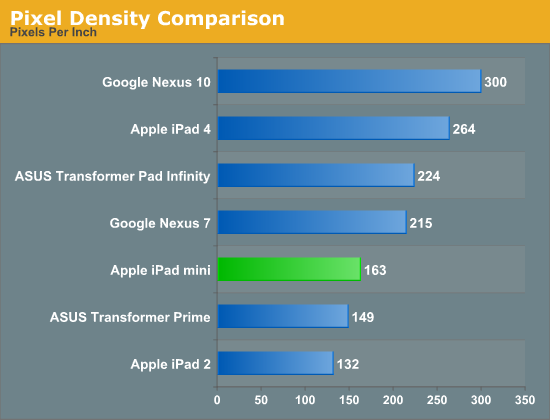
Doing the math on the mini's 1024 x 768 display results in a pixel density of 163 pixels per inch. A tangible improvement compared to the original iPad's 132 PPI, but keep in mind the smaller screen may have to be held closer to your eyes. Compared to other tablets, the mini's display resolution isn't anything to write home about. In practice, the mini's makes reading small text a problem:

While the 3rd and 4th gen iPads have a large enough display at a high enough resolution to make it possible to view the Dell configurator in the photo above without zooming, the same can't be said for the iPad mini. You're going to need a double tap.
Although reading text is one area where the absence of insane numbers of pixels is clearly obvious, it's visible in some photos as well.

iPad mini (left) vs. iPad 4 (right)
Where a lack of fine detail doesn't get you, the physical size of the display may. I was pleasantly surprised by the usefulness of Apple's 7.85-inch display, but given my early affinity towards 8-inch tablets it's not too shocking. Despite how useful the mini's display is, I found myself having to double tap to zoom in on most desktop websites just to make the reading a bit better. It's not that the process of zooming in on a website in mobile Safari is particularly cumbersome, it's that the fact that I have to makes me feel like I'm using more of an iPod Touch and less of an iPad. I do admit the feeling is quite irrational as I prefer keeping the iPod Touch (or iPhone in the case of, reality) holstered and using the mini instead. This is less a criticism of the iPad mini and more guidance for those deciding between mini and regular sizes of the iPad.
Compared to a true 7-inch tablet like the Nexus 7, the additional screen size is definitely appreciated - particularly when reading web pages:
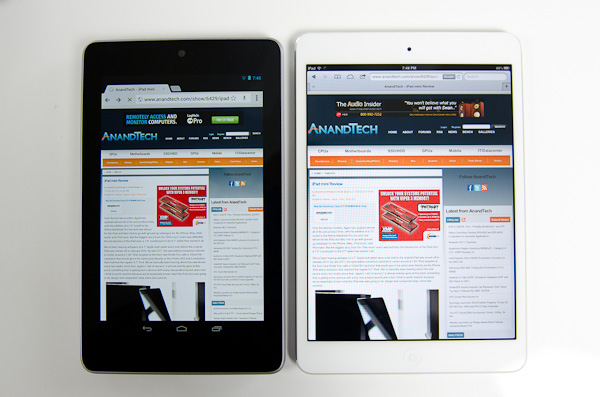
Nexus 7 (left) vs iPad mini (right)
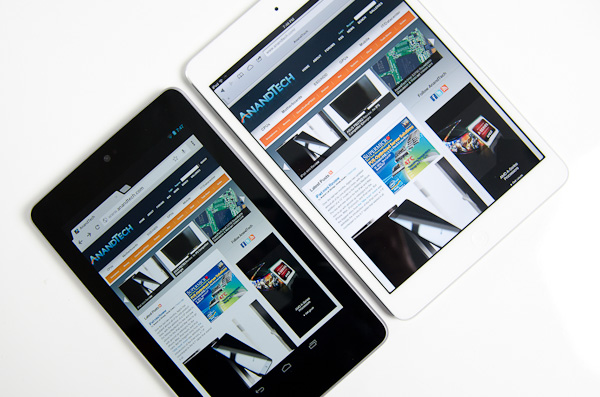
Nexus 7 (left) vs iPad mini (right)
When Vivek and I brought up the topic of the mini's lower pixel density on the Podcast, our own Brian Klug pointed out the obvious: we're spoiled. How impressed/unimpressed you are with the iPad mini's display really depends on what other displays you've been exposed to. In a vacuum, the iPad mini's display is fine. Brightness, black levels and contrast are all reasonable (and much better than most notebooks). Color reproduction isn't bad either. In the spectrum of all displays available at the mini's price point, this 7.85-inch 1024 x 768 panel isn't bad. Spend any appreciable time with the bigger iPad's Retina Display however, and your opinion will quickly change.


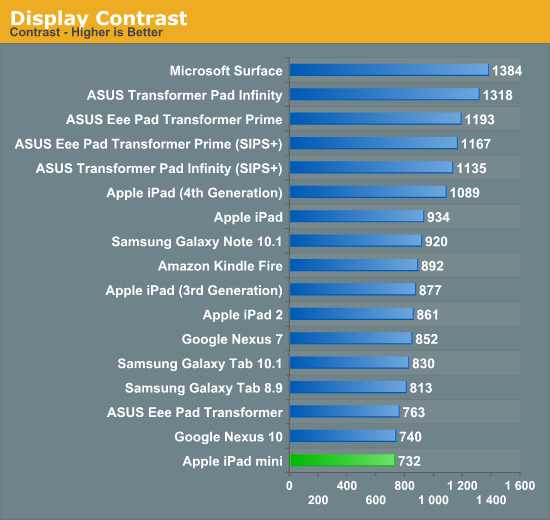
In our Surface review I titled the display section "Not Retina, But Still Good". Compared to the Surface display, the mini has better color accuracy but clearly loses out in black levels thanks to Microsoft's laminated display + cover glass stack.
To evaluate color accuracy I turned to our own Chris Heinonen's CalMAN smartphone/tablet workflow. We'll start off by looking at the calibrated white point for these tablets. What you're looking for here is a number close to 6500K:
The mini doesn't really diverge from other iPads here, although Microsoft comes closer to 6500K at 200 nits.
The next three charts look at accuracy represented as a difference between various source colors and what's reproduced on the display. The results are presented as average dE2000, with lower numbers being better.
First up is Grayscale performance, here we're looking at the accuracy of black, white and 19 shades of gray spread in between the two extremes:
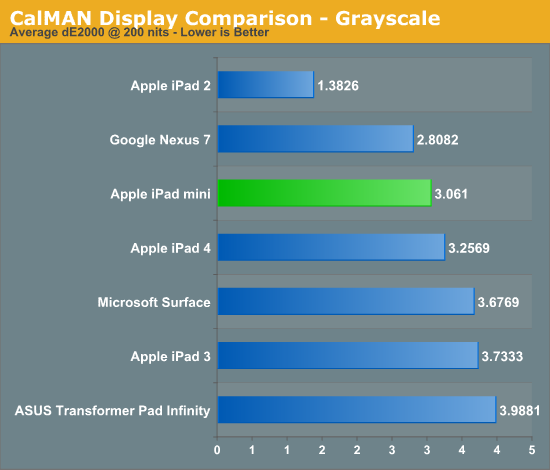
The mini does reasonably well here, it actually ends up a bit better than the 4th gen iPad. Grayscale accuracy doesn't seem to be too difficult for most folks to get right, but what happens when we start looking at colors?
First in our color accuracy tests is a saturation sweep. Here we're looking at 20%, 40%, 60%, 80% and 100% saturations of red, blue, green, magenta, yellow and cyan.
Now we start to see the retina equipped iPads pull away from the mini. Compared to the iPad 2 and even Microsoft's Surface, the mini looks pretty good, but if you compare it to the Nexus 7 or newer iPads it's clearly at a disadvantage. All of these displays are significantly better than the average notebook panel. As I mentioned earlier, it all boils down to perspective and expectations.
Gamut CIE Chart

Saturation CIE Chart

For our final accuracy test we're looking at the difference between a Gretag Macbeth colorchecker chart and the rendered swatches on these displays. Once again, lower numbers are better.
Once again, the iPad 3/4 can't be touched here, with the iPad mini falling significantly behind. Colors simply look better on the bigger iPads. The Nexus 7 does better here as well. Subjectively I found colors on the Nexus 7 to look appreciably more accurate than on the mini.
GMB Color Checker
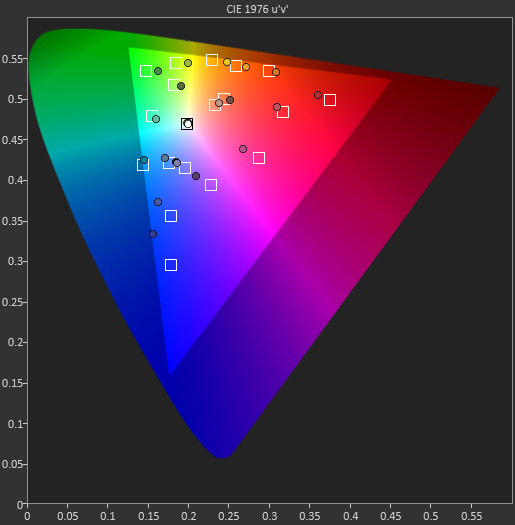
With regards to the quality and accuracy of the images rendered on the mini's screen, I feel the same way about it as I do the display on Surface: it's not a Retina display, but still good.


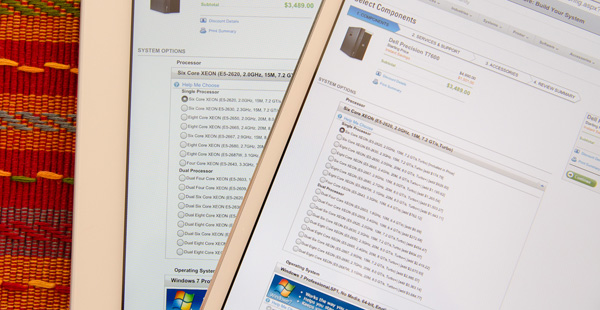
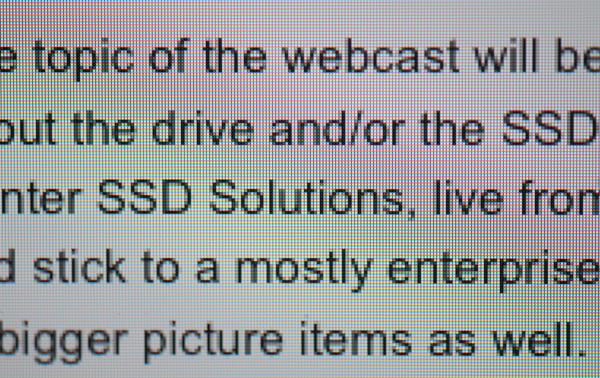
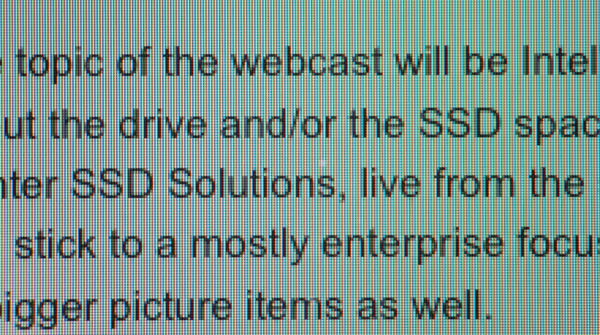
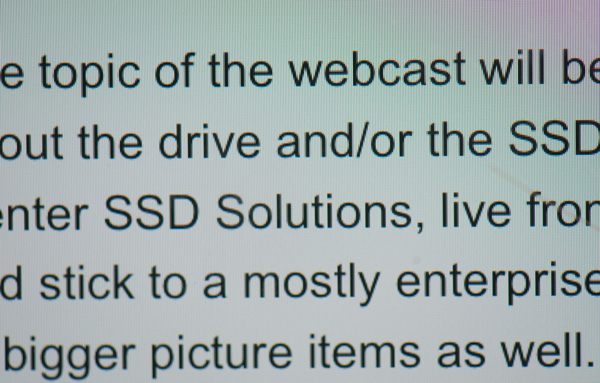
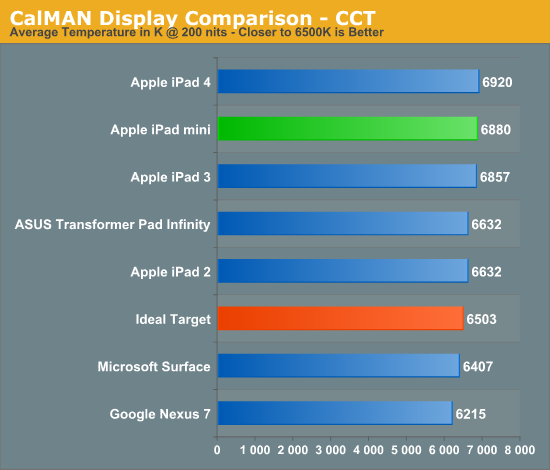
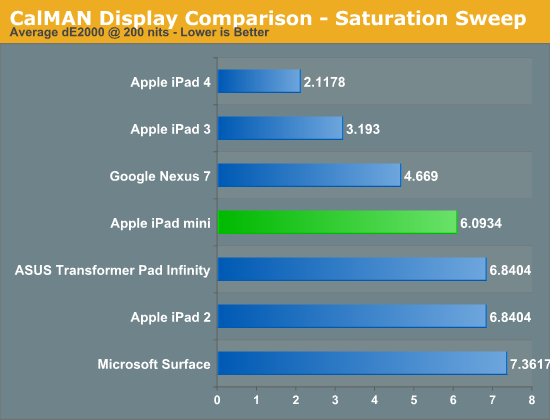
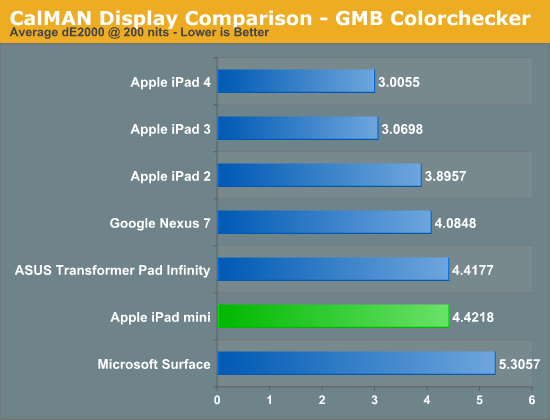








140 Comments
View All Comments
Constructor - Monday, November 26, 2012 - link
You keep it from even installing any of the offered updates and then you complain that it doesn't work as well as it should?Look into a mirror one of these days if you're searching for the source of your problems.
KPOM - Wednesday, November 21, 2012 - link
I have a 3rd gen iPad and decided to give the mini a try. I was a little reluctant because of the display (it is definitely a step down from the 3rd gen), but I agree with Anand that the form factor is great. The full size iPad is a little heavy to hold and read on a train or airplane, but the mini excels at that. Hopefully Anand is wrong and Apple can figure out a way to get a Retina Display into the mini form factor sometime in 2013. If they do, I think that the mini would actually be the preferred iPad choice overall.I had an original Kindle Fire last year, but never used it much and wound up selling it. I think I'll keep the iPad mini, though for now I also think I'll keep the 3rd gen iPad.
ABR - Wednesday, November 21, 2012 - link
The Mini is all well-and-good for the "carry-it-anywhere-squint-and-peer" crowd, but as someone who mainly uses my iPad on the couch and such around the house, I'd rather have one with a BIGGER display, not smaller. Make it thinner so there's no weight penalty, and with a display about the size of an 8-1/2x11 sheet, or a standard magazine. (Particularly since magazine and other media consumption is a big use.)uhuznaa - Wednesday, November 21, 2012 - link
There's no way to make it thinner or just weight the same with a larger display. The display is a major power consument in tablets, make it larger, brighter or in a higher resolution and it draws *much* more power.PrayForDeath - Wednesday, November 21, 2012 - link
Hey Ananad,When can we expect to see the iPad 4 review? I'd love to read your in-depth analysis on the new hardware and how it compares to previous generations.
chleuasme - Wednesday, November 21, 2012 - link
Why on your pictures for the comparison of the letter 'e' and the 'topic of the webcast' text, the RGB components of pixels appear vertically aligned on the mini, and horizontally aligned on the iPad 2. And the contrary on the Safari icon comparison on the mini vs the 4?chleuasme - Wednesday, November 21, 2012 - link
And same* thing* on the Safari iconA.T. - Wednesday, November 21, 2012 - link
Please some "fanboy" leaves an and staff alone. I think they did a fair comparison, and comment about it. It is foolish to say that is 1 and a half year technology, why don't those fanboy army try to make it and fit the 45nm A5X or A6 with holding 10 hours battery life without make it thicker.It is a nice device for reading and easy to carry around but there is a downsize to become a productive tool at work. The price is relatively expensive than other, but the thing is Apple is a company that unlike google and amazon to cut their throat and sell it with no profit because Apple is software and hardware company and Google and amazon is ads and service company.
pliablemoosethebanned - Wednesday, November 21, 2012 - link
I bought a N7, and use it every day,I'll be selling the N7 and replacing it with a mini, will likely wait till it hits the Apple refurb store though.
Build quality: the iPad mini wins, hands down,
Form factor: again, a big plus, the thing feels more like an e-reader than a tablet, and the extra screen real estate does make a big difference. 7" is just too small for a great smaller tablet experience.
Software: Yeah, iOS is due for an overhaul, but frankly, I have never used widgets that much, preferring to use folders to group the actual apps. I tire of widget overload, saw an SGN II the other day with the home screen filled with widgets and it was way too damn busy.
And as far as the "OMFG, Anand is biased" comments, give it a flipping rest, the man benches the crap out of the latest and greatest on a nearly daily basis, can he be allowed to like something you don't?
Anand likely cost Apple millions by proving the antenna system on the iP4 was defective, and he has some very strong empirically proven data that the iPad mini is a parts bin device with a screen that lags the industry. Yet the device meets his needs.
Spoelie - Thursday, November 22, 2012 - link
http://www.displaymate.com/iPad_mini_ShootOut_1.ht...It seems the reflections are the worst of its problems, as this tablet is more likely to be used outside